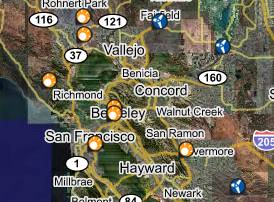Thursday Topsight, July 6, 02006
 Monday doesn't come until Thursday this week.
Monday doesn't come until Thursday this week.
• Green Nuclear: "Don't get me wrong: I love nuclear energy! It's just that I prefer fusion to fission. And it just so happens that there's an enormous fusion reactor safely banked a few million miles from us. It delivers more than we could ever use in just about 8 minutes. And it's wireless!"
- William McDonough, ecological designer, author of Cradle to Cradle, quoted at Z+ Blog.
• Success Stories: In my talk at TED, I called for the creation of a mashup of cameraphone uploads, satellite maps, and sensory data on environmental change. At one point, I said this:
Many of those who participate in Earth Witness would focus on ecological problems, human-caused or otherwise, especially environmental crimes and significant sources of greenhouse gas emissions. That's understandable; we need better documentation of what's happening to the planet if we want any chance of repairing the damage. But the Earth Witness program wouldn't need to be limited to problems; in the best WorldChanging tradition, it would also serve as a showcase for good ideas, successful projects, and efforts to make a difference that deserve much more visibility. Earth Witness would show us two worlds: the world we are leaving behind, and the world we are building for generations to come.
It looks like bits and pieces of this idea are sprouting up. Treehugger points to "The Renewable Planet," a Google Maps mashup that pinpoints the locations of a multitude of renewable energy projects around the world, including wind power farms, solar arrays, biofuel facilities, and "other" (largely hydrokinetic power).
Seems to me they need to add an option for zero energy footprint and ultra high efficiency buildings, too. Who's up for making a LEED Map?
• Mapping as Politics: Yesterday's ruminations about the right terminology for futurism notwithstanding, I have a serious fascination with the use of geography and geographic representation for social and political change. Maps serve both functional and symbolic purposes, showing us the relationship between locations as well as showing us our place in the world. The rise of networked, interactive and dynamic maps heightens both the symbolic power and the representational capacities of maps. Regine at We Make Money Not Art (a blog I'll always think of under its original alternative name, Near Near Future) reports on the Terminal Air project, a proposal to link dynamic maps, data from the US Federal Aviation Administration, and so-called "planespotters" to chart the path of the torture taxis -- the planes used by the CIA and other US government groups to ferry prisoners out of the country to enable allies to interrogate them as brutally as they'd like.
We need a term for mass bottom-up observation of official activities. Sousveillance is useful, but it seems to apply most often to individual activities -- I'm talking about "crowdsourced" sousveillance. Now that I mention it, "Crowdsourced Sousveillance" isn't bad, but is a real mouthful of jargon. "Participatory Panopticon" might work, but although the term is resonant when spoken, it is also too ungainly for widespread use. Any suggestions?
• Next Stop, Alpha Centauri: In the computer addiction game Civilization, the most idealistic way to win is to launch a space ship to the (currently) closest star system, Alpha Centauri, with the goal of colonization. New research suggests that this might someday be a plausible goal. The astronomy weblog Centauri Dreams reports that Alpha Centauri's dim, sullen member Proxima Centauri is at just the right distance to serve as a catalyst for flinging comets into the Alpha Centauri system. While we quite reasonably worry about comets giving us a serious smack, it turns out that they're critically important in planetary evolution, as they provide water and other "volatiles" -- molecules that would have been boiled away in the earliest stages of a planet's existence, but are necessary once a planet cools in order for Life As We Know It to emerge.
(The Y10K-compatible dating format is a hat-tip to a new friend, Long Now intern and University of Hawaii Center for Future Studies grad student Stuart Candy.)





